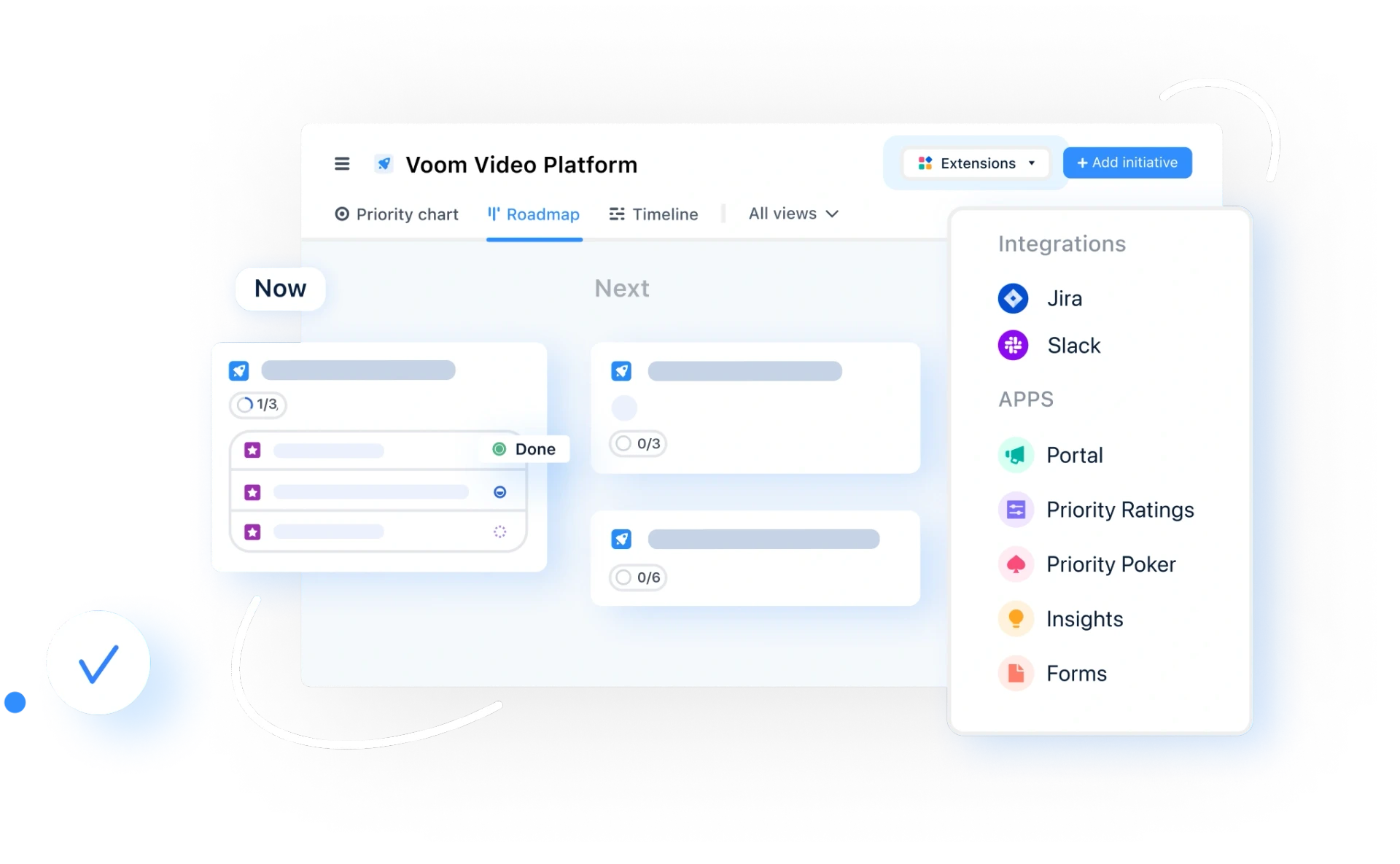
‘Flexibility’ has become one of those buzzwords that every software company seems to claim. But when you’re running product teams with competing priorities, multiple stakeholders, and fast-changing markets, flexibility needs to be more than just a tagline. It has to be real, and it has to make a difference every single day.
At airfocus, flexibility is more than just a feature of our software. It’s a philosophy that shapes how the platform was built, and how it continues to evolve. To explore what this really means, we spoke with Julia Baumgartner, Customer Success Manager at airfocus, and Malte Scholz, CEO and co-founder. Together, they revealed how airfocus’ flexibility shows up for product teams of every size and why it’s become a defining advantage.
Why flexibility is a strategic advantage
Product leaders today operate in a landscape defined by constant change. They face an environment where customer expectations can shift seemingly overnight, technologies disrupt established workflows, and internal structures evolve as companies grow or reorganize. What worked yesterday might not work tomorrow, and rigid tools can quickly become a barrier rather than a help.
The reality is that no two product teams are alike, even within the same company. Some work in sprints, others lean into OKRs, and many may use hybrid approaches that combine elements of different frameworks.
That’s why the ability to shape a platform around your way of working is so critical. Flexibility means that you can accommodate new frameworks without retraining entire teams, or roll out consistent standards without stifling creativity, and adjust priorities without losing alignment across your business.
“Nearly 8 out of ten product managers tell us that flexibility is crucial to product success,” Julia says. “Flexibility is fundamental to building products that work.”
Malte agrees: “We built airfocus on the principle of flexibility from day one. Product leaders don’t want to be forced into a rigid framework. They want a platform that adapts to how they already work.”
Ultimately, flexibility is about resilience. It gives teams the confidence that they can evolve their processes, meet the needs of different teams, scale to meet new challenges, and, most importantly, respond to change without being slowed down by their tools.
One company, many teams, many needs
A product organization is rarely uniform. One group may be experimenting with lean startup methods and another may be deep in enterprise-grade planning cycles, while others might be hybrid mixes of agile, OKRs, or custom approaches. As any product leader will know, this diversity creates both a strength and a challenge. Leaders need consistency and visibility, but they also need to respect the way individual teams get their best work done.
That’s where flexibility becomes so critical. A product management tool has to be capable of serving very different needs within the same organization. The startup founder wants quick setup and clarity. The scale-up CTO wants to empower multiple squads without introducing chaos. The enterprise VP of Product needs to align dozens of teams under one strategy while still giving them autonomy.
“airfocus serves all these diverse needs,” Julia explains. “For startups, flexibility means fast customization without disrupting how they already work. They can be up and running quickly, on their own terms.”
But the enterprise picture looks different: “For larger enterprises, flexibility is even more critical,” she continues. “Multiple teams can build their own workflows within one platform – what we like to call a powerful product OS that scales with the company.”
This duality is the heart of airfocus’ flexibility. The same platform must empower a 10-person team shipping weekly updates and a 50-team global organization executing a multi-year product roadmap. airfocus makes this possible, giving teams freedom while offering leaders a coherent, aligned view of strategy and progress.
Balancing flexibility with simplicity
Flexibility is only valuable, though, if people can actually use it. Too often, software that promises adaptability ends up overwhelming teams with too many options and settings, or confusing workflows. This not only wastes your team’s time but also puts them off using their tools. For product leaders, this presents a paradox: they need a platform robust enough to handle complex scenarios, but simple enough that teams of all sizes can onboard quickly.
This is where airfocus deliberately sets itself apart. The entire platform is designed to deliver the benefits of flexibility without the friction. airfocus achieves this balance by:
Keeping the interface clean and free of distractions
Embedding best practices directly into the tool
Providing ready-to-use templates that work out of the box
Backing it all up with hands-on customer support
“We focus on an easy-to-use, intuitive interface,” Julia explains. “We don’t overload people with features they don’t need or add unnecessary noise. Instead, we provide a lot of built-in guidance, best practices, and ready-to-use templates you can activate with a simple click.
“And if you do need help, our customer success team is always there, which is something users consistently tell us makes a huge difference. Our users often tell us that our support team was a big help in making the setup smooth and stress-free.”
What flexibility looks like in practice
So what does flexibility actually look like when you log into airfocus? Too often, flexibility is talked about as an abstract concept. In practice it means concrete choices: the ability to model workflows to fit your business, to adjust how you prioritize work, and to control how data flows between tools. It means every team, whether discovery-focused, delivery-focused, or a mix of both, can reflect its reality inside the platform without friction.
Flexibility at airfocus isn’t vague. It’s tangible, and almost every part of the platform can be adapted:
Workflows and fields
Teams can create end-to-end processes that reflect their exact business setup. “Almost everything in airfocus can be adapted,” Julia explains, “from workflows and fields to roadmaps and templates.” This means a discovery-driven team can build a very different workflow from a delivery-focused team, yet both can coexist within the same organization.
Prioritization frameworks
No two companies prioritize in the same way. With airfocus, you can customize scoring formulas or build your own from scratch. “Every company prioritizes differently,” Julia says. “That’s why we let you design your own formulas.” Some organizations run RICE or ICE, while others use proprietary scoring models. airfocus accommodates all of them.
Roadmaps and templates
Views can be sliced and diced for different stakeholders. Executives see high-level strategy and outcomes, while engineers see tactical work. Flexible templates ensure consistency without compromising relevance.
Integrations
Perhaps the most underrated form of flexibility. “Our Jira and Azure DevOps integrations are among the most flexible out there,” Julia notes. “You can decide at the field level whether to sync data one-way or two-way, giving you complete control.” This prevents the rigid syncing problems that plague other tools and lets product leaders design integrations that mirror their real-world processes.
How airfocus adds flexibility for your team
To put this all into perspective, let’s imagine two different organizations. A five-person startup might use airfocus to connect Jira lightly – just enough to keep their backlog aligned – while ignoring the features they don’t need yet. Meanwhile, a 5,000-person enterprise might rely on the same integration to synchronize multiple Jira instances across dozens of teams, field by field, with nuanced rules for what flows back and forth. Both are valid approaches, and both are supported by airfocus.
Our flexibility also extends to layering features. A small startup might keep things lean with just roadmaps and prioritization, while a multinational enterprise can add OKRs, capacity planning, and insight management to create a comprehensive product OS. Teams can expand their setup as they mature, without being forced to overhaul their workflows.
This flexibility means airfocus can mirror the way your teams already work, instead of forcing them into someone else’s idea of “best practice.”
Supporting teams at every stage of maturity
airfocus’ flexibility also matters when it comes to maturity. Not every team has a fully developed product management process. For those just starting out, airfocus provides a guided path forward.
“If you’re new to product management, our template library makes it really easy to get started,” Julia says. “You can use them as they are, or adapt them to your style.”
These templates span a wide range of methodologies and best practices, from Kanban boards to OKR-driven roadmaps, giving new teams confidence that they’re building on solid ground. airfocus’ customer success managers often step in at this stage to coach teams through their first cycles and help them adopt workflows that feel natural rather than imposed.
And as teams grow, airfocus grows with them. “airfocus is modular: you can start with just the basics, then add more applications as your team matures,” Julia says. That might mean layering in prioritization frameworks once a backlog expands, introducing capacity planning as multiple squads form, or rolling up individual roadmaps into portfolio-level views for executives.
For highly mature organizations, flexibility takes another form: governance. airfocus makes it possible to enforce certain standards across the organization, while still letting teams maintain autonomy in how they deliver work.
Beyond the tool itself, airfocus supports product leaders with resources like ebooks, the airfocus Academy, and webinars featuring industry experts such as Marty Cagan. Teams at every stage can learn, adapt, and evolve without feeling left behind.
Why airfocus stands apart
Many platforms in the product management space call themselves customizable, but few truly let teams shape their workflows around existing practices.
“What really sets airfocus apart is that we don’t require you to change how you work,” Julia says. “The platform scales with you in the environment you already know.”
Customers often discover this only after trying less flexible alternatives. “Customers often tell us they switched because other tools forced them into one rigid methodology,” Julia adds. “With airfocus, you’re in control.”
This flexibility strengthens alignment, improves stakeholder trust, and accelerates decision-making: benefits that cascade through your entire business.
Flexibility that builds confidence
In the end, flexibility is about confidence. Confidence that your teams can work their way, that you can align stakeholders without compromise, and that your platform will scale with you as your organization evolves.
airfocus delivers on that promise with a simple yet powerful product management platform that adapts to your needs, not the other way around.
Emma-Lily Pendleton
Read also



Experience the new way of doing product management

Experience the new way of doing product management




